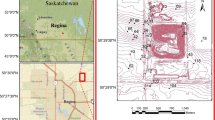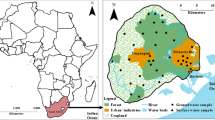Abstract
Two non-parametric kriging methods such as indicator kriging and probability kriging were compared and used to estimate the probability of concentrations of Cu, Fe, and Mn higher than a threshold value in groundwater. In indicator kriging, experimental semivariogram values were fitted well in spherical model for Fe and Mn. Exponential model was found to be best for all the metals in probability kriging and for Cu in indicator kriging. The probability maps of all the metals exhibited an increasing risk of pollution over the entire study area. Probability kriging estimator incorporates the information about order relations which the indicator kriging does not, has improved the accuracy of estimating the probability of metal concentrations in groundwater being higher than a threshold value. Evaluation of these two spatial interpolation methods through mean error (ME), mean square error (MSE), kriged reduced mean error (KRME), and kriged reduced mean square error (KRMSE) showed 3.52% better performance of probability kriging over indicator kriging. The combined result of these two kriging method indicated that on an average 26.34%, 65.36%, and 99.55% area for Cu, Fe, and Mn, respectively, are coming under the risk zone with probability of exceedance from a cutoff value is 0.6 or more. The groundwater quality map pictorially represents groundwater zones as “desirable” or “undesirable” for drinking. Thus the geostatistical approach is very much helpful for the planners and decision makers to devise policy guidelines for efficient management of the groundwater resources so as to enhance groundwater recharge and minimize the pollution level.
Similar content being viewed by others
References
Bureau of Indian Standard (BIS) (1991). Indian standard specification for drinking water. New Delhi: BIS Publication No. IS: 10501.
Carr, J. R. (1994). Order relation correction experiments for probability kriging. Mathematical Geology, 26, 605–621.
Carr, J. R., & Mao, N. (1993). A general form of probability kriging for estimation of the indicator and uniform transforms. Mathematical Geology, 25, 425–438.
Central Ground Water Board (CGWB) (2006). Ground water year book, National Capital Territory, Delhi. New Delhi: Ministry of Water Resources, Government of India.
Chiueh, P. T., Lo, S. L., & Lee, C. D. (1997). Prototype SDSS for using probability analysis in soil contamination. Journal of Environmental Engineering (ASCE), 123, 514–519.
ESRI (Environmental Systems Research Institute) (2004). ArcGIS 9. Redlands, California, New York, USA.
Gamma Design Software, LLC (1988). GS+. Michigan, USA.
Goovaerts, P. (1994). Comparative performance of indicator algorithms for modelling conditional probability distribution function. Mathematical Geology, 26, 389–411.
Goovaerts, P. (1997). Geostatistics for natural resource evaluation. New York: Oxford University.
Goovaerts, P., AvRuskin, G., Meiliker, J., Slotnick, M., Jacquez, G., & Nriagu, J. (2005). Geostatistical modeling of the spatial variability of arsenic in groundwater of southeast Michigan. Water Resources Research, 41, 1–19.
Isaaks, E. H., & Srivastava, R. M. (1989). An introduction to applied geostatistics. New York: Oxford University.
Johnston, K., Hoef, J. M. V., Krivoruchko, K., & Lucas, N. (1996). Using ArcGIS geostatistical analysis (pp. 120–187). GIS User Manual by ESRI, New York.
Journel, A. G. (1988). Non-parametric geostatistics for risk and additional sampling assessment. In L. H. Keith (Ed.), Principles of environmental sampling (pp. 45–72). Washington, DC: American Chemical Society.
Journel, A. G. (1989). Fundamentals of geostatistics in five lessons. Short course in geology (Vol. 8). Washington, DC: American Geophysical Union.
Journel, A. G., & Deutsch, C. V. (1997). Rank order geostatistics: A proposal for a unique coding and common processing of diverse data. In: E. Y. Baafi & N. A. Schofield (Eds.), Geostatistics Wollogong 96, quantitative geology and geostatistics (Vol 8, pp. 174–187). Boston: Kluwer Academic.
Juang, K. W., & Lee, D. Y. (1998). Simple indicator kriging for estimating the probability of incorrectly delineating hazardous area in a contaminated site. Environmental Science Technology, 32, 2487–2493.
Juang, K. W., & Lee, D. Y. (2000). Comparison of three nonparametric kriging methods for delineating heavy metal contaminated soils. Journal of Environmental Quality, 29, 197–205.
Juang, K. W., Lee, D. Y., & Hsiao, C. K. (1998). Kriging with cumulative function of order statistics for delineation of heavy metals contaminated soil. Soil Science, 163, 797–804.
Kumar, D., & Ahmed, S. (2003). Seasonal behaviour of spatial variability of groundwater level in a granitic aquifer in monsoon climate. Current Science, 84, 188–196.
Lado, L. R., Hengl, T., & Reuter, I. (2008). Heavy metal in Europian soils: A geostatistical analysis of the FORGES geochemical database. Geoderma, 148, 189–199.
Lee, J. J., Jang, C. S., Wang, S. W., & Liu, C. W. (2007). Evaluation of potential health risk of arsenic-affected groundwater using indicator kriging and dose response model. Science of the Total Environment, 384, 151–162.
Liu, X., Zhang, W., Zhang, M., Ficklin, D. L., & Wang, F. (2009). Spatio-temporal variations of soil nutrients influenced by an altered land tenure system in China. Geoderma, 152, 23–34.
Lu, P., Su, Y., Niu, Z., & Wu, J. (2007). Geostatistical analysis and risk assessment on soil total nitrogen and total soil phosphorus in the dongting lake plain area, China. Journal of Environmental Quality, 36, 935–942.
Orton, T. G., Rawlins, B. G., & Lark, R. M. (2009). Using measurement close to a detection limit in a geostatistical case study to predict selenium concentration in topsoil. Geoderma, 152, 269–282.
Oyedele, D. J., Amusan, A. A., & Olu, O. (1996). The use of multiple variable indicator kriging technique for the assessment of the suitability of an acid soil for maize. Tropical Agriculture, 73, 259–263.
Santra, P., Chopra, U. K., & Chakraborty, D. (2008). Spatial variability of soil properties and its application in predicting surface map of hydraulic parameters in an agricultural farm. Current Science, 95, 937–945.
Sarangi, A., Cox, C. A., & Madramootoo, C. A. (2005). Geostatistical methods for prediction of spatial variability of rainfall in a mountainous region. Transactions of ASAE, 48, 943–954.
Stacey, K. F., Lark, R. M., Whitmore, A. P., & Milne, A. E. (2006). Using a process model and regression kriging to improve predictions of nitrous oxide emission from soil. Geoderma, 135, 107–117.
Author information
Authors and Affiliations
Corresponding author
Rights and permissions
About this article
Cite this article
Adhikary, P.P., Dash, C.J., Bej, R. et al. Indicator and probability kriging methods for delineating Cu, Fe, and Mn contamination in groundwater of Najafgarh Block, Delhi, India. Environ Monit Assess 176, 663–676 (2011). https://doi.org/10.1007/s10661-010-1611-4
Received:
Accepted:
Published:
Issue Date:
DOI: https://doi.org/10.1007/s10661-010-1611-4




